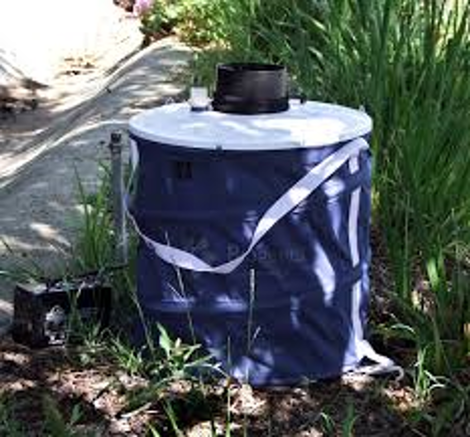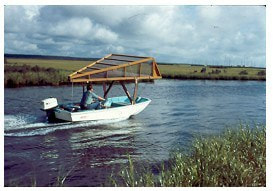Ocean County Mosquito Commission Surveillance Program
One of the key aspects of surveillance is the process of collecting mosquitoes for analysis. Our program focuses on a variety of different trapping practices to collect our mosquitoes for species analysis, population studies, and viral testing at the NJ PHEAL Lab. Each type of trap uses a different medium to attract mosquitoes at all different stages. Listed below are the traps we use and how they work.
Light Traps

This trap is used for population studies and our county has 28 different trap locations situated all throughout the county.
The lure is a 25 watt bulb that attracts all different insects into the trap, which our summer seasonal lab helpers and the ID specialist sort through everyday to take accurate analysis of only the mosquitoes found in the traps.
This trap is very good at catching a wide variety of mosquitoes and providing information about how pesticide application and water management projects are working.
These stationary traps have a solar sensor that turns the light on at night and off during the day. They are collected daily from May-October in the "North" or "South" light trap run. During this collection our workers also take a landing rate count to see how many mosquitoes are actively seeking a blood meal in each location, with an additional 32 locations stopped at during these collections for only landing rate count analysis. A total of 60 locations in Ocean County every day!
We have light trap data for many of our traps going as far back as 1960!
The lure is a 25 watt bulb that attracts all different insects into the trap, which our summer seasonal lab helpers and the ID specialist sort through everyday to take accurate analysis of only the mosquitoes found in the traps.
This trap is very good at catching a wide variety of mosquitoes and providing information about how pesticide application and water management projects are working.
These stationary traps have a solar sensor that turns the light on at night and off during the day. They are collected daily from May-October in the "North" or "South" light trap run. During this collection our workers also take a landing rate count to see how many mosquitoes are actively seeking a blood meal in each location, with an additional 32 locations stopped at during these collections for only landing rate count analysis. A total of 60 locations in Ocean County every day!
We have light trap data for many of our traps going as far back as 1960!
Gravid Traps

These traps are made to target 'gravid' or egg baring females. These mosquitoes are collected as live samples and flash frozen on dry ice to prepare them for testing.
The lure is a stink water; which is made by our superintendent who has become a master at creating the stinkiest stink water. He uses grass clippings that he allows to decompose in the water for months.
This is an excellent collection for mosquitoes that may contain virus because you know the mosquito has blood fed in order to produce it's eggs. (See mosquito information on how they do this!)
These traps run over night and are collected each morning at multiple locations throughout the county from May-October.
The lure is a stink water; which is made by our superintendent who has become a master at creating the stinkiest stink water. He uses grass clippings that he allows to decompose in the water for months.
This is an excellent collection for mosquitoes that may contain virus because you know the mosquito has blood fed in order to produce it's eggs. (See mosquito information on how they do this!)
These traps run over night and are collected each morning at multiple locations throughout the county from May-October.
CDC Traps
|
These traps are used to trap bridge vector mosquitoes, which may pass diseases between different species of animals.
The lure for this trap is CO2 produced from dry ice and light. This is an excellent trap for collecting a variety of mosquitoes that may bite humans and cause a threat for spreading diseases because of their attraction to the gas exchange of CO2. This trap is set at night and collected ever morning, usually beside the Gravid trap in different locations all through out the county. This trap is also set from May-October and live samples are collected to be sent to the state lab for testing. |
BG Traps

This is a species specific trap, excellent at trapping the locally found invasive species Aedes albopictus (Asian Tiger Mosquito) and Aedes aegypti in other parts of the country and world.
The lure is a scented lure that is supposed to mimic the smell of a human, but it smells TERRIBLE! I wonder if that is how they truly smell us (so gross)!
This trap is very good at catching residential human biting mosquitoes, because these mosquitoes do not travel far from their breeding sites. (Find more information about the Asian tiger Mosquito here)
These traps are set at dusk and are collected in the morning. They are usually set in different locations than the Gravid and CDC traps, because they are set to target 'backyard' breeding habitat mosquitoes.
The lure is a scented lure that is supposed to mimic the smell of a human, but it smells TERRIBLE! I wonder if that is how they truly smell us (so gross)!
This trap is very good at catching residential human biting mosquitoes, because these mosquitoes do not travel far from their breeding sites. (Find more information about the Asian tiger Mosquito here)
These traps are set at dusk and are collected in the morning. They are usually set in different locations than the Gravid and CDC traps, because they are set to target 'backyard' breeding habitat mosquitoes.
Resting Boxes

These boxes are placed in specific locations that are known for mosquitoes to rest. Since mosquitoes tend to rest during the day, they seek refuge in these boxes and are collected when they are not active.
The Ocean County Mosquito Commission utilizes these boxes in locations that may have higher numbers of the Culiseta melanura, which are a vector species that are known to bite both birds and mammals, possibly spreading Eastern Equine Encephalitis (EEE). These boxes can also collect Culex species which transmit West Nile Virus.
The lure is nothing more than the daytime sun and the heat of the summer.
These traps are collected once a week in the late morning or early afternoon and mosquitoes are put directly on ice to be tested at the state lab.
Black Widow Spiders and Wolf Spiders love to make these boxes their homes for laying their eggs. An added element of excitement for our workers to find new surprises in them every week!
The Ocean County Mosquito Commission utilizes these boxes in locations that may have higher numbers of the Culiseta melanura, which are a vector species that are known to bite both birds and mammals, possibly spreading Eastern Equine Encephalitis (EEE). These boxes can also collect Culex species which transmit West Nile Virus.
The lure is nothing more than the daytime sun and the heat of the summer.
These traps are collected once a week in the late morning or early afternoon and mosquitoes are put directly on ice to be tested at the state lab.
Black Widow Spiders and Wolf Spiders love to make these boxes their homes for laying their eggs. An added element of excitement for our workers to find new surprises in them every week!
Truck and Boat Traps (no longer used)

A large screen funnel is attached to the top of a truck or boat to catch male and females in flight. This is the best trap to get an idea of male vs. female population, because it does not use any luring techniques. This isn't an effective collection technique anymore because of all of the other insects it catches in flight that may be beneficial to the ecological landscape where the collection is occurring. We do everything we can not to disrupt the natural ecosystem, and no longer use this as a trapping technique.

